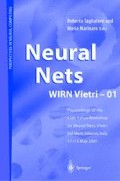Abstract
Localistic versus distributive processing are seemingly antagonistic views of the central nervous system general function. The issue gives rise to complex philosophical debates that, stemming from the monistic-dualistic everliving debate, invocate justification from anatomical, functional and psychological observations. A brief sketch of the current debates is given.
Access this chapter
Tax calculation will be finalised at checkout
Purchases are for personal use only
Preview
Unable to display preview. Download preview PDF.
References
Popper, K. R. (1977). Some remarks on panpsychism and epiphenomenalism. Dialectica 31:177–86.
Popper, K. & Eccles, J. (1977). The Self and Its Brain: An Argument for Interactionism. Springer Verlag, Berlin Heidelberg New York.
Eccles, J. 1987. Brain and mind: Two or one? In (C. Blakemore & S. Greenfield, eds) Mindwaves. Blackwell.
Hart, W. D. (1988). The Engines of the Soul. Cambridge University Press.
Nagel, T. (1993). What is the mind-body problem? In Experimental and Theoretical Studies of Consciousness (Ciba Foundation Symposium 174). Wiley. New York, Chichester.
Chalmers, D. J. (1996). Can consciousness be reductively explained? In The Conscious Mind. Oxford University Press.
Chalmers, D. J. (1996). The Conscious Mind: In Search of a Fundamental Theory. Oxford University Press, Oxford
Chalmers, D. J. (1997). Availability: The cognitive basis of experience? In (N. Block, O. Flanagan, and G. Guzeldere, eds) The Nature of Consciousness. MIT Press.
Chalmers, D.J. (1999) What is a neural correlate of consciousness? In Neural Correlates of Consciousness: Conceptual and Empirical Questions (Metzinger, T., ed.), MIT Press
Levine, J. (1983). Materialism and qualia: the explanatory gap. Pacific Philos. Q. 64, 354–361
Kim, J. (1997). The mind-body problem: Taking stock after forty years. Philosophical Perspectives 11:185–207.
Davidson, D. (1970) Mental Events, (reprinted in Davidson, D. (1980). Essays on actions and Events. Oxford University Press, Oxford.
Feinberg, T. E. (1997). The irreducible perspectives of consciousness. Seminars in Neurology 17:85–93.
Kirk, R. (1982). Physicalism, identity, and strict implication. Ratio 24:131–41.
Fodor, J. (1983). The modularity of mind, Bradford Books, MIT Press, Cambridge, Mass.
Hill, C. S. (1991). Sensations: A Defense of Type Materialism. University Press.Cambridge. Cambridge, Mass.
Levine, J. (1983). Materialism and qualia: the explanatory gap. Pacific Philos. Q. 64, 354–361
Block, N. (1995) On a confusion about a function of consciousness. Behav. Brain Sci. 18, 227–287
Block, N. & Stalnaker, R. (1999). Conceptual analysis, dualism, and the explanatory gap. Philosophical Review.
Chalmers, D. J. (1995). Facing up to the problem of consciousness. Journal of Consciousness Studies 2:200–19.
Robinson, H. (ed) (1993). Objections to Physicalism. Oxford University Press, Oxford.
Dennett, D. C. & Kinsbourne, M. (1992). Time and the observer: The where and when of consciousness in the brain. Behav. Brain Sci. 15:183–201.
Dennett, D.C. (1991). Consciousness Explained, Little, Brown
Edelman, G. M. (1987). Neural Darwinism: The Theory of Neuronal Group Selection (Basic, New York).
Crick, F. and Koch, C. (1990) Towards a neurobiological theory of consciousness. Semin. Neurosci. 2, 263–275
Crick, F. and Koch, C. (1995). Why neuroscience may be able to explain consciousness. Sci. Am. 273(6):84–85.
Llinas, R.R. et al. (1994). Content and context in temporal thalamocortical binding. In Temporal Coding in the Brain (Buzsaki, G. et al., eds), Springer Verlag, Berlin Heidelberg New York.
Flohr, H. (1995) Sensations and brain processes. Behav. Brain Res.71, 157–161.
Hobson, J.A. (1997) Consciousness as a state-dependent phenomenon. In Scientific Approaches to Consciousness (Cohen, J. and Schooler, J., eds), pp. 379–396, Lawrence Erlbaum
Kurthen, M. et al. (1998) Will there be a neuroscientific theory of consciousness? Trends Cognit. Sci. 2, 229–234.
Atkinson, A. P. Thomas M.S.C. and Cleeremans, A.(2000) Consciousness: mapping the theoretical landscape.TICS, 4: 372–382.
Atkinson, R.C. and Shiffrin, R.M. (1971) The control of short-term memory. Sci. Am. 224, 82–90.
Rolls, E.T. (1998) The Brain and Emotion, Oxford University Press, Oxford.
O’Brien, G. & Opie, J. (1997). Cognitive science and phenomenal consciousness: A dilemma, and how to avoid it. Philos. Psychol. 10:269–86.
O’Brien, G. and Opie, J. (1999) A connectionist theory of phenomenal experience. Behav. Brain Sci. 22, 127–196
Sperry, R. W. (1992). Turnabout on consciousness: A mentalist view. J. Mind Behav. 13:259–80.
Tononi, G. and Edelman, G.M. (1998) Consciousness and complexity. Science 282: 1846–1851
Edelman, G.M. and Tononi G. (2000). A universe of Consciousness. Basic Books, New Tork.
Purves, D., Riddle, D.R. and LaMantia, A.S (1992). Iterated patterns of brain circuitry (or how the cortex gets its spots). TINS 15: 362–368.
Author information
Authors and Affiliations
Editor information
Editors and Affiliations
Rights and permissions
Copyright information
© 2002 Springer-Verlag London Limited
About this paper
Cite this paper
Biella, G.E.M. (2002). Where thought lives: place or palace?. In: Tagliaferri, R., Marinaro, M. (eds) Neural Nets WIRN Vietri-01. Perspectives in Neural Computing. Springer, London. https://doi.org/10.1007/978-1-4471-0219-9_35
Download citation
DOI: https://doi.org/10.1007/978-1-4471-0219-9_35
Publisher Name: Springer, London
Print ISBN: 978-1-85233-505-2
Online ISBN: 978-1-4471-0219-9
eBook Packages: Springer Book Archive

